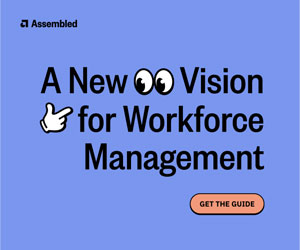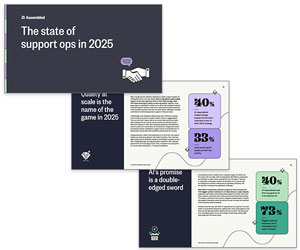Whitney Rose at Assembled explores why many in-house AI projects stall, what drives the build vs. buy dilemma, and how CX leaders can make smarter choices to achieve lasting impact.
If your AI project looked great in the demo but already feels shaky in production, you’re not alone. Most internal builds plateau at partial automation, drain resources, and get deprioritized before they ever deliver real ROI.
The problem isn’t your team – it’s the build vs. buy trap. Here’s why it happens, and what leading CX organizations are doing instead.
Why Build Looks Good on Paper
At first glance, building AI in-house can look like the smart move.
- Perceived cost savings: Direct access to LLMs feels cheaper than paying vendor fees. But those “savings” only hold if you ignore the real costs of upkeep, compliance, and speed.
- Data control: In regulated industries, the ability to self-host and enforce strict governance makes building seem safer.
- Engineering capacity: Enterprises with large developer benches often see AI as just another project to throw resources at.
- Perceived uniqueness: Leaders sometimes believe their business is too specific for off-the-shelf tools, and building feels like a way to capture institutional knowledge in custom workflows.
These motivations explain why the debate resurfaces, but they’re more perception than reality. Only 11% of enterprises actually end up running custom AI at scale. Most start with optimism, then stall once the hidden costs and complexity show up.
Where Builds Break Down
Spinning up an internal AI prototype is easy. A few engineers, a demo that handles the top requests, and leadership feels momentum. The trouble starts when you try to scale from demo to production.
The failure modes are predictable:
- Edge cases: Support is full of long-tail scenarios. An internal build might cover the top 10% of requests, but customers don’t forgive the 90% that fall through the cracks.
- System handoffs: AI doesn’t work in isolation, it has to integrate cleanly with CRMs, ticketing systems, and escalation paths. Latency, broken connections, and bad routing turn a win into a liability.
- Maintenance load: What begins as a side project becomes another platform to maintain. Priorities shift, engineers get reassigned, and the AI stops evolving with the business.
We’ve seen the same pattern again and again: internal projects plateau around 10–20% automation. That’s enough to prove the concept, but nowhere near enough to transform operations.
And once progress slows, continued investment gets harder to justify, leaving the business with a half-built solution that doesn’t move the needle.
AI Moves Faster Than You Can Build
Even if an internal build clears the first hurdles, there’s a bigger problem: the ground keeps shifting.
In traditional software, infrastructure decisions last years. In AI, they last months, sometimes weeks. Models leapfrog each other.
Benchmarks flip. Techniques that felt cutting-edge six months ago already look dated. Even experts can’t agree on which approaches will stand the test of time.
That volatility creates two risks:
- Speed – Custom builds often take 9–18 months to deploy. Vendor solutions can launch 5–7 months faster. In a market where breakthroughs happen every quarter, that lag means your tool risks being obsolete before it’s even live.
- Impact – MIT research shows 95% of enterprise AI pilots fail to deliver meaningful results. Internal builds succeed only about a third of the time. Partnerships with specialized vendors succeed nearly twice as often.
The takeaway is stark: AI moves too quickly for most enterprises to keep pace alone. By the time an internal system ships, the market has already moved on.
Why “Cheaper” is an Illusion
Building rarely saves money, it just hides the costs. The comparison looks favourable only if you ignore what it actually takes to run AI at scale.
- Maintenance: Models drift, integrations break, and upkeep becomes a permanent tax.
- Compliance: Enterprises don’t just need working AI — they need it monitored, audited, and secured.
- Headcount: Every engineer pulled into AI maintenance is an engineer pulled away from core product or customer work.
- Opportunity cost: While internal teams are patching, competitors on vendor solutions are already compounding value.
Support leaders tell us the same story: what looked like a margin lift in year one turned into negative ROI once hidden costs and delays piled up. “Cheaper” isn’t cheaper, it’s just deferred expense.
What Smart Buyers Do Differently
If builds tend to stall, why do some enterprises see real results from buying? It’s not just about getting access to the latest models – it’s about everything wrapped around them.
The most successful buyers focus on three things:
- Support-specific workflows – Generic AI can summarize text, but it won’t handle escalations, route tickets, or plug into workforce management. Specialized vendors design for these realities from day one.
- Interoperability – AI doesn’t live in a silo. It has to work seamlessly with CRMs, help desks, QA tools, telephony, and more. Buyers who prioritize deep integrations see faster time to value and fewer operational headaches.
- Continuous evolution – The AI market doesn’t stand still, and neither can your tooling. Strong vendors retrain models, update integrations, and track the ecosystem so internal teams don’t have to.
That’s why buying isn’t just outsourcing. It’s compounding. Instead of betting on a fragile internal build, buyers are betting on a partnership that gets stronger over time, and lets their own teams stay focused on outcomes, not infrastructure.
Build vs. Buy is Really About Focus
At its core, the build vs. buy question isn’t about technology or even cost, it’s about where you choose to focus.
For most enterprises, running AI infrastructure is not a core competency. Delivering excellent support, protecting customer trust, and building brand loyalty are. Every hour spent keeping an internal AI system alive is an hour not spent improving the customer experience.
That doesn’t mean enterprises should never build. Building makes sense when it ties directly to your unique differentiation, the “secret sauce” no one else can replicate. But AI support infrastructure rarely fits that description. It’s foundational, not differentiating.
That’s why so many internal projects eventually get deprioritized. What began as an ambitious experiment becomes a distraction from what matters most.
Buying, in this context, isn’t a shortcut, it’s a strategic choice to focus resources where they move the business forward.
The Smarter Bet: Buy
The evidence is clear: internal builds stall, drain resources, and fall behind the market. Buying, on the other hand, compounds value, giving you workflows, integrations, and reliability that scale as fast as the market shifts.
Your job isn’t to maintain AI infrastructure. Your job is to deliver customer experiences that build trust and loyalty. And that’s why the smarter bet, the one that compounds over time, isn’t to build. It’s to buy.
This blog post has been re-published by kind permission of Assembled – View the Original Article
For more information about Assembled - visit the Assembled Website
Call Centre Helper is not responsible for the content of these guest blog posts. The opinions expressed in this article are those of the author, and do not necessarily reflect those of Call Centre Helper.
Author: Assembled
Reviewed by: Jo Robinson
Published On: 26th Sep 2025
Read more about - Guest Blogs, Assembled, Whitney Rose






 Assembled is a Support Operations platform that helps companies maintain exceptional customer experiences, no matter what lies ahead. Leading brands use Assembled's workforce and vendor management capabilities to make optimal staffing decisions, gain visibility into performance and productivity, and unlock new ways to serve evolving customer needs.
Assembled is a Support Operations platform that helps companies maintain exceptional customer experiences, no matter what lies ahead. Leading brands use Assembled's workforce and vendor management capabilities to make optimal staffing decisions, gain visibility into performance and productivity, and unlock new ways to serve evolving customer needs. 












